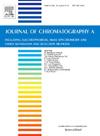Investigation and characterization of deep eutectic solvent (DES) based stationary phase in gas chromatography
IF 3.8
2区 化学
Q1 BIOCHEMICAL RESEARCH METHODS
引用次数: 0
Abstract
In this study, the preparation of the stationary phase based on the deep eutectic solvent (DES) was investigated along with the measurement of thermodynamic parameters. The physical characterization of the synthesized sample was investigated by Thermogravimetric (TGA), scanning electron microscope (SEM) and Fourier Transform Infrared Spectrometer (FTIR) analyses. Thermodynamic parameters measured to express the potential ability of the constructed stationary phase were McReynolds constants, partition coefficient, Abraham system constants, ∆, activity coefficient at infinite dilution (), and selectivity (). For this purpose, the parameters were investigated in different amounts of stationary phase (SP) loading including 5, 10, 15 and 18 %w/w and also at three temperatures of 40, 70 and 100 °C. The prepared stationary phase with moderate polarity had the potential to separate BTEXs, aromatic compounds and alcohols due to strong interactions caused by hydrogen bonds. It was investigated the improved performance of the stationary phase prepared with carbowax. Finally, the performance of SP-DES stationary phase separation was investigated for different analytes including alkanes, alcohols and aromatic compounds.
基于深共晶溶剂 (DES) 的气相色谱固定相的研究与表征。
本研究对基于深共晶溶剂(DES)的固定相的制备进行了研究,并对热力学参数进行了测量。通过热重(TGA)、扫描电子显微镜(SEM)和傅立叶变换红外光谱仪(FTIR)分析研究了合成样品的物理特性。测量的热力学参数包括麦克雷诺常数、分配系数、亚伯拉罕系统常数 ∆ 、无限稀释时的活性系数 (γi∞) 和选择性 (Sij∞),以表示所构建的固定相的潜在能力。为此,研究了不同固定相(SP)负载量(包括 5%、10%、15% 和 18%w/w)以及 40、70 和 100 °C 三种温度下的参数。所制备的极性适中的固定相由于氢键的强烈相互作用,具有分离 BTEX、芳香族化合物和醇类的潜力。研究还发现,使用卡波蜡制备的固定相性能更好。最后,研究了 SP-DES 固定相分离不同分析物(包括烷烃、醇类和芳香族化合物)的性能。
本文章由计算机程序翻译,如有差异,请以英文原文为准。
求助全文
约1分钟内获得全文
求助全文
来源期刊

Journal of Chromatography A
化学-分析化学
CiteScore
7.90
自引率
14.60%
发文量
742
审稿时长
45 days
期刊介绍:
The Journal of Chromatography A provides a forum for the publication of original research and critical reviews on all aspects of fundamental and applied separation science. The scope of the journal includes chromatography and related techniques, electromigration techniques (e.g. electrophoresis, electrochromatography), hyphenated and other multi-dimensional techniques, sample preparation, and detection methods such as mass spectrometry. Contributions consist mainly of research papers dealing with the theory of separation methods, instrumental developments and analytical and preparative applications of general interest.
 求助内容:
求助内容: 应助结果提醒方式:
应助结果提醒方式:


